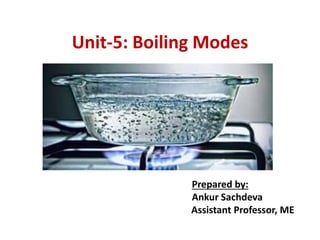
Boiling and its various Modes.pdf
- 1. Unit-5: Boiling Modes Prepared by: Ankur Sachdeva Assistant Professor, ME
- 2. Boiling and Evaporation • The phase change from liquid to vapour at liquid vapour interface is called the boiling. • Boiling is a convective heat transfer process that involves phase change at a constant temperature from liquid to vapour. • During the boiling, the heat added to liquid for its phase change is the latent heat. • Evaporation occurs at the liquid–vapor interface when the vapor pressure is less than the saturation pressure of the liquid at a given temperature. • Boiling, on the other hand, occurs at the solid–liquid interface when a liquid is brought into contact with a surface maintained at a temperature Ts ,sufficiently above the saturation temperature, Tsat ,of the liquid.
- 3. Modes of Boiling • The growth of vapour and its dynamics depend on temperature excess, nature of surface and thermo-physical properties of liquid, such as its surface tension, latent heat etc. • Various modes of boiling – Pool Boiling – Flow Boiling – Saturated Boiling – Sub-cooled Boiling
- 4. Modes of Boiling: Pool & Flow • Pool boiling. It refers to a situation in which the heated surface is submerged below the free surface of a stagnant liquid and its motion near the surface is due to free convection only and the mixing is induced by bubble growth and its detachment. • Forced convection boiling. It refers to a situation of boiling, in which the fluid motion is induced artificially by an external means as well as by natural convection and the bubble induced mixing. – This type of boiling occurs in high pressure water tube boilers involving forced convection.
- 5. Modes of Boiling: Sub-cooled and Saturated • Sub-cooled or local boiling. It refers to a situation of boiling, in which the temperature of the liquid is below its saturation temperature and the bubbles formed at the heated surface are condensed in the liquid as they leave the surface. • Saturated boiling. It refers to a situation of boiling, in which the temperature of the liquid is equal to its saturation temperature. – The bubbles formed at the heated surface are pushed through the liquid by buoyancy effects to escape from free surface of the liquid
- 6. Pool Boiling Regimes (For water at 1 atm)
- 7. Pool Boiling Regimes: Region I • Free convection boiling: In the region I, the temperature excess ΔTe ≤ ΔTe,A ≅ 5°C, the free convection currents, are responsible for fluid motion and heat transfer. • The liquid near the heated surface is slightly superheated and evaporates when it rises the surface.
- 8. Pool Boiling Regimes: Region II & III • Nucleate Boiling: The nucleate boiling exists when ΔTe,A ≤ ΔTe ≤ ΔTe, C ≅ 30°C. • In this range, the two different flow regimes may be distinguished: Region-II and Region-III. • In the region II, the bubbles begin to form at some nucleation sites on the surface of the wire and are collapsed in the liquid after detaching from the surface. • This region II is referred as unstable or isolated nucleate boiling (A – B).
- 9. Pool Boiling Regimes: Region II & III • Nucleate Boiling: As the temperature excess is increased further in the region III, more nucleation sites become active and the bubbles form more rapidly and rise to free surface of the liquid and form slugs of vapour. • It is stable nucleate boiling (B – C). • The interference between the densely populated bubbles retard the motion of the liquid near the surface.
- 10. Some Important Points on Boiling Curve • Inflection point: The point P in the boiling curve at which the heat transfer coefficient h reaches maximum value. • Critical Heat Flux : The peak of curve at point C is the locus of maximum heat flux, where the excess temperature is raised to about 35°C. – At this point, the temperature of the surface exceeds the melting point of solid and thus the melting of wire may occur – It is also known as burn-out point or boiling crisis.
- 11. Pool Boiling Regimes: Region IV • Unstable Film Boiling(C – D): In this region IV, ∆Te,C ≤ ∆Te ≤ ∆Te,D ≅ 120°C. • Bubble formation is so high that the vapour film form on the fraction of surface. • At any point on the surface, the film and nucleate boiling may appear alternatively but the growth of film increases with increase in ∆Te . • This film prevents the inflow of fresh liquid taking their place
- 12. Pool Boiling Regimes: Region V • Film Boiling: It appears in region V, when ∆Te ≥ 120°C, the surface is completely covered by vapour blanket. • The heat flux becomes minimum at point D. • The heat transfer from the surface to the liquid occurs by conduction through the stable vapour film. • As the surface temperature increases, the heat flux slowly increases due to increase in h.
